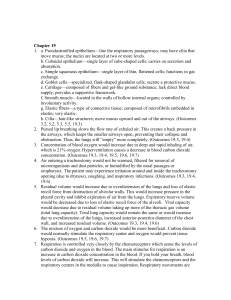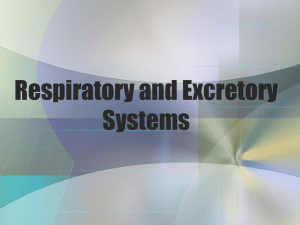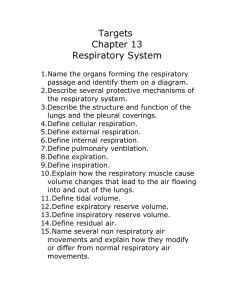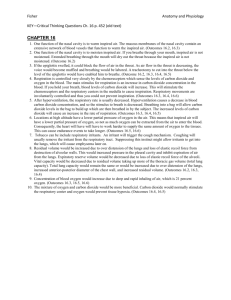Learning About the Respiratory System
advertisement
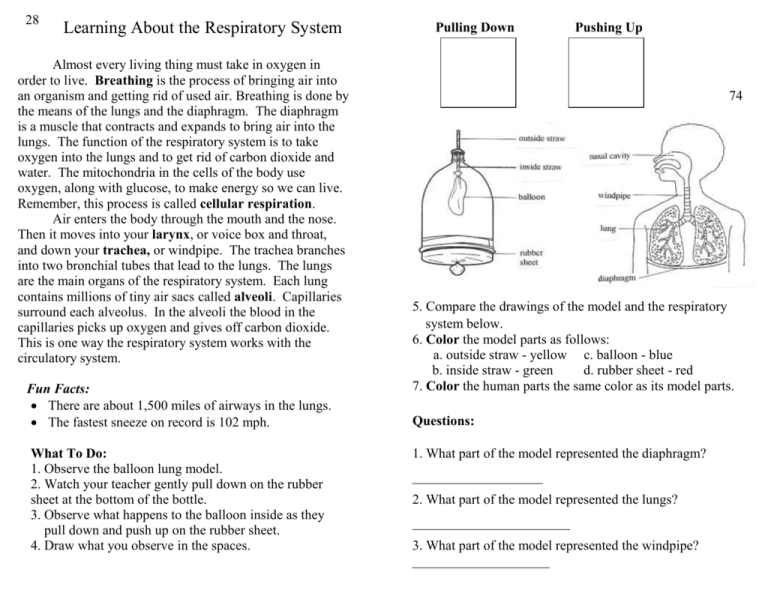
28 Learning About the Respiratory System Almost every living thing must take in oxygen in order to live. Breathing is the process of bringing air into an organism and getting rid of used air. Breathing is done by the means of the lungs and the diaphragm. The diaphragm is a muscle that contracts and expands to bring air into the lungs. The function of the respiratory system is to take oxygen into the lungs and to get rid of carbon dioxide and water. The mitochondria in the cells of the body use oxygen, along with glucose, to make energy so we can live. Remember, this process is called cellular respiration. Air enters the body through the mouth and the nose. Then it moves into your larynx, or voice box and throat, and down your trachea, or windpipe. The trachea branches into two bronchial tubes that lead to the lungs. The lungs are the main organs of the respiratory system. Each lung contains millions of tiny air sacs called alveoli. Capillaries surround each alveolus. In the alveoli the blood in the capillaries picks up oxygen and gives off carbon dioxide. This is one way the respiratory system works with the circulatory system. Fun Facts: There are about 1,500 miles of airways in the lungs. The fastest sneeze on record is 102 mph. What To Do: 1. Observe the balloon lung model. 2. Watch your teacher gently pull down on the rubber sheet at the bottom of the bottle. 3. Observe what happens to the balloon inside as they pull down and push up on the rubber sheet. 4. Draw what you observe in the spaces. Pulling Down Pushing Up 74 5. Compare the drawings of the model and the respiratory system below. 6. Color the model parts as follows: a. outside straw - yellow c. balloon - blue b. inside straw - green d. rubber sheet - red 7. Color the human parts the same color as its model parts. Questions: 1. What part of the model represented the diaphragm? ___________________ 2. What part of the model represented the lungs? _______________________ 3. What part of the model represented the windpipe? ____________________ 75 76 Changing The Rate of Breathing Materials: clock or timer What To Do: 1. As your teacher watches the clock, count the number of inhales you make in 15 sec. 4. Place the number in the chart below and “DO THE MATH” for 60 seconds! 5. Stand up and sit down in your chair 25 times. 6. Count your inhales for 15 seconds and “DO THE MATH” for 60 seconds! 15 seconds Number of breaths (At Rest) Number of breaths (After Exercise) 60 seconds X4= X4= Questions: 1. What happens to your breathing rate after exercise? ______________________ 2. Why do you think this happens? (Think about how the mitochondria uses oxygen.) _________________________________________ Collect the data from all the people at your table and place it in the chart below. Name of Student Breathing Rate after exercise Make a bar graph with the data from your table. 77 Name _______________________ period _____ 77 Name _______________________ period _____ EXIT TICKET EXIT TICKET Learning About the Respiratory System Learning About the Respiratory System 1. What is the major waste material our lungs exhale? A. Oxygen B. Nitrogen C. Carbon Dioxide D. Helium 1. What is the major function of the respiratory system? A. Take oxygen in and get rid of carbon dioxide. B. Take carbon dioxide in and get rid of oxygen. C. Make energy using carbon dioxide D. Make energy using oxygen 2. What is the major component of air that our body needs? 2. What is the major waste material our lungs exhale? A. Oxygen B. Nitrogen C. Carbon Dioxide D. Helium A. Oxygen B. Nitrogen C. Carbon Dioxide D. Helium 3. What are the main organs of the respiratory system? 2. What is the major component of air that our body needs? A. Hearts B. Kidneys C. Lungs D. Fingers A. Oxygen B. Nitrogen C. Carbon Dioxide D. Helium 4. What is the major function of the respiratory system? 3. What are the main organs of the respiratory system? A. Take oxygen in and get rid of carbon dioxide. B. Take carbon dioxide in and get rid of oxygen. C. Make energy using carbon dioxide D. Make energy using oxygen A. Hearts B. Kidneys C. Lungs D. Fingers





